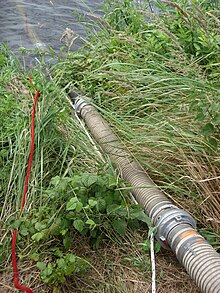Fire line
A fire brigade line (also lifeline or fire brigade safety line ) is a line made for special purposes of the fire brigade . For fire brigades in Germany , their specifications are laid down in DIN 14920.
The term fire brigade leash does not exist in the Austrian fire brigade , and it is only used colloquially for all lines used in the fire brigade service. In Austria it is standardized according to ÖNORM F5260.
tasks
The fire line is used:
- for rescuing people (only if no fall protection device set is available)
- for self-rescue
- to secure the way back
- for self-protection / securing of devices
In the most extreme emergency, the fire line is used to rescue people or to rescue the emergency services themselves (e.g. a trapped squad who rappels down).
conditions
Fire lines must be checked regularly and retired 20 years after the date of manufacture. So is
- to subject the line to a visual inspection after each use,
- In Germany, the line must be checked in detail once a year by specially trained people.
A line manufactured according to DIN 14920 must consist of spiral-braided polyester fibers , be 30 m long, have a diameter of 10 mm and a tear strength of 14 kN (1.4 t) and be white. A wooden toggle or a snap hook is regularly spliced into the end of the line .
A discarded line can still be used as a multi-purpose line (also called a work line). To do this, it must be at least partially marked in red and no longer be used to secure people. A typical area of application for multi-purpose lines is, for example, the integration of a suction line .
storage
In order to be able to use a leash safely, it has been proven to be stored in linen bags, so that it can be pulled out again easily and without tangling when used. Most linen bags have a strap to hang them around. A tie rope is often carried in the linen bag.
Use in areas at risk of falling
The fire brigade rope is not able to dynamically absorb impacts into the rope, therefore emergency services may not use it for securing if falls cannot be ruled out. Thus the term "suspension line" is out of date. It is only suitable for holding people, i.e. H. if the anchor point is above the fire brigade to be secured and the line is always taut. A fall protection kit is required for all other applications . This consists of a dynamic kernmantle rope and other accessories. The fire brigade puts on a special full body harness and is connected to the rope by means of a figure-of-eight knot . In Germany, it is secured with an HMS carabiner and a half-mast throw protection . Securing in areas at risk of falling should be known to every fire service member, in contrast to height rescue , which requires extensive special training and regular exercises.
Designations in Austria
The term fire line is not used as an official name by the Austrian fire brigades. The following three types of lines are used instead in Austria:
Lifeline
The lifeline is a line that may only be used for rescuing and securing people. It is a kernmantle rope according to EN 1891 with a diameter of 11 mm and a length of 20 or 30 meters and has a light metal carabiner at one end. The lifeline is kept in a bag for protection. It must be checked every year and withdrawn after six years.
Working line
The work line can be used for various activities such as lashing down equipment, pulling up spray pipes or to mark the way back during an internal attack. Retired lifelines can be dyed red and used as a work line. It is not subject to any inspection intervals. Working lines must not be used for personal safety.
Valve or suction hose leash
It is a ten meter long, thin line with a steel carabiner at one end. It is used to open the check valve of a suction head , to relieve the suction line or to prevent the suction hose from being driven off.
Tie or leash
As a rule, it is 8–12 mm thick and 6 m long, but it is not standardized. This line shape is used for all conceivable fastenings, as fastenings can be made relatively quickly due to the shortness. As in the water service, this line is also used in the KHD application for lacing in wooden structures.
literature
- Lothar Schott, Manfred Ritter: Fire Brigade Basic Course FwDV 2 . 20th edition. Wenzel-Verlag, Marburg 2018, ISBN 978-3-88293-220-1 .
Web links
Individual evidence
- ↑ Test principles for equipment and devices of the fire brigade . (PDF) BGG / GUV-G 9102, December 2009.

